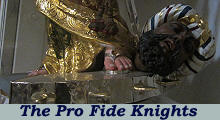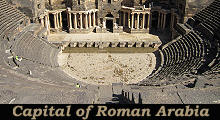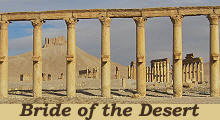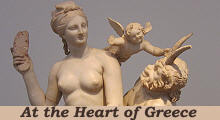

What's New!
Detailed Sitemap
All images © by Roberto Piperno, owner of the domain. Write to romapip@quipo.it. Text edited by Rosamie Moore.
Page added in March 2012.
|
 - The Grand Masters of the XVIth century - The Grand Masters of the XVIth century
(detail of a statue of St. Catherine of the Wheel in the parish church of Zejtun)
This page is illustrated with coats of arms of the Grand Masters. A brief outline of the history of Malta before 1530 is provided in a separate page.
A 13 di Novembre, come nuovo Principe accompagnato da tutti i Signori della Gran Croce (..) fu con grandissimo applauso ricevuto nella
Città Notabile dall'Ecclesiastico, dal Magistrato, da tutti i Nobili, e da tutto il resto del Popolo (..) havendo prima esso Signor Gran Maestro
alla porta della Città, la qual per cerimonia gli fecero trovar chiusa, reiterato il giuramento d'osservargli i privilegi loro ed essendosi state doppo presentate due chiavi d'argento, fu aperta la porta.
"On November 13, 1530 Grand Master Philippe Villiers de l'Isle Adam made his entrance into Città Notabile (Mdina) accompanied by his knights. He was received with great applause by the Bishop, the Judge, the noblemen and all the citizens. Prior to entering the town Grand Master Villiers stopped at the main gate, which was closed. He made an oath of respecting the privileges of Città Notabile and at this point he was given two silver keys and the gate was open.
"
Excerpt from Della descrittione di Malta, isola nel mare Siciliano by Fra Giovanfrancesco Abela, Knight of the Order of St. John, published in 1648.
Philippe Villiers de l'Isle Adam (1521-34) (courtyard of the Grand Masters Palace in Valletta)
The description of Villiers' entrance into Città Notabile was written more than a century after the event. Villiers
accepted the offer of Malta made to him by Emperor Charles V, only as
a temporary mean to avoid the dissolution of the Order.
From Malta he hoped to reconquer Rhodes and the other possessions the Knights surrendered to Sultan Suleyman the Magnificent in 1522.
Villiers, instead of placing his residence in Città Notabile, the capital of the island, chose to stay at Borgo, the main harbour.
In the following years the Knights' small fleet joined the Spanish one in raids along the coast of the Peloponnese where the fortresses of Modon and Coroni were seized for a short time.
The Spanish raids were retaliation for those of Ottoman corsairs on the coasts of Spain and Italy, rather than a realistic attempt to conquer territories in the Aegean Sea.
Juan de Homedes y Coscon (1536-53) (walls of Città Notabile/Mdina)
During the short governments of the two following Grand Masters (Pietrino del Ponte and Didier de Tholon Sainte-Jaille), the Knights
continued to fight at the side of the Spaniards; their greatest achievement was having contributed to the capture of Tunis in 1535, which however had been prompted by a revolt of Christian prisoners inside the castle.
The appointment in 1536 of Grand Master Juan de Homedes y Coscon led to an even closer alliance with Spain. Maltese ships took part in the Battle of Preveza in 1538 which ended in disaster for the Christian fleet. Ottoman corsairs led by Hayr-ad-Din Barbarossa and after him by Turgut Reis (aka Dragut) raided the coasts of Malta. In 1551 Dragut ousted the Knights from Tripoli which Charles V had given them together with Malta. In that same year Dragut landed on Gozo, seized the citadel and took the whole population of the island into slavery. Some historians charge Grand Master Homedes of having been too subservient to the Spaniards and of not having cared enough about protecting Malta.
Claude de la Sengle (1553-57); (left) coat of arms of the municipality of Senglea (Isla) which is identical to that of the Grand Master; (right) the "Guardiola" of Senglea
During their long history the Knights had to deal with the fact that the countries from which they came were at war. They were helped in remaining united by their common faith, but the long series of wars between France and Spain in the first half of the XVIth century caused frictions between the knights of the three French tongues (France, Provence and Auvergne) and those of the two Spanish tongues (Aragon and Castile).
Homedes was succeeded by French Grand Master Claude de la Sengle who concentrated his efforts on protecting Malta, an objective which all Knights shared. He built an imposing bastion (St. Michael) and other fortifications at Isola (island), a long and narrow peninsula opposite Borgo which was renamed Senglea.
Jean Parisot de Valette (1557-68) (Grand Masters Palace in Valletta)
In February 1560 a large Christian fleet sailed from Malta towards Tripoli with the aim of reconquering that town; eventually the objective of the expedition changed and the ships landed more than 10,000 troops on Djerba, an island in southern Tunisia which was easily occupied. While the Christians were fortifying their positions a large Ottoman fleet commanded by Piyale Pacha arrived at Djerba and attacked the invaders.
The expedition ended with more than 5,000 men captured by the Ottomans.
The fact that the Christian fleet gathered on Malta to sail towards Tripoli, led Sultan Suleyman to set himself the objective of conquering the island.
In winter 1565 preparations for the invasion of Malta were made at Constantinople, but they did not go unnoticed by Venetian and Maltese spies.
Grand Master Valette fortified the defences of Borgo, Senglea and Fort S. Elmo at the entrance of the great harbour and he alerted the Spanish Viceroy of Sicily on the forthcoming invasion.
The Great Siege of Malta, fresco by Matteo Perez d'Aleccio in the Grand Masters Palace at Valletta: 1) Fort S. Elmo; 2) Borgo; 3) Senglea; 4) Dragut Point
The Ottomans landed in May and they laid siege to Fort S. Elmo to acquire control of the entrance to the great harbour; they eventually succeeded in their objective, but only on June 23 their flag was raised on the fort; they suffered heavy losses and in the fight Dragut was killed.
At the end of June the Knights at Borgo received some reinforcement troops from Sicily (soccorso minore). The Ottomans laid siege to Borgo and Senglea, but their attacks were repelled. Lala Mustafa Pacha, the Ottoman commander, did not have a clear strategy. He tried to seize Città Notabile (Mdina), but the attempt failed and by doing this he lessened the pressure on Borgo and Senglea.
Eventually on September 7 other Christian reinforcement troops landed on Malta (soccorso maggiore).
Mustafa Pacha overestimated their number and hastily ordered his men to leave the island.
Grand Master Valette decided that the Order needed a see appropriate to the status it had acquired by defeating the Ottomans (after a very long period of Ottoman victories). The Great Siege had shown that the main peninsula of the great harbour could not be protected only by Fort S. Elmo, which was located at its tip. Valette therefore decided to build a new town there. The design of its fortifications and of its urban layout was entrusted to Francesco Laparelli, a military engineer who had designed the new walls of Castel Sant'Angelo in Rome for
Pope Pius IV. The first stone of La Valetta, the new town, was laid on March 28, 1566.
Pietro del Monte (1568-72); (left) portrait in St. Lawrence's at Borgo/Città Vittoriosa; (right) coat of arms of Pope Julius III at Palazzo Spada in Rome)
Relations between the Order and Rome became so strong that Pietro del Monte, Maltese Ambassador to the Papal State, was elected Grand Master after Valette. He was nephew of Pope Julius III (Giovanni Maria Ciocchi del Monte) and he had adopted his uncle's surname and coat of arms. He continued the construction of Valletta and when Francesco Laparelli expressed the desire to leave Malta, Del Monte replaced him with Girolamo Cassar.
Cassar had learnt the ropes of military architecture from Laparelli, but the Grand Master wanted him to design also the auberges (hostels/meeting places) for the Knights, the palace for himself and the churches of the new town. Cassar was therefore sent to Rome to become familiar with
Italian Renaissance architecture.
In 1570 the Ottomans landed on Cyprus, a Venetian possession.
They were commanded by Lala Mustafa Pacha who was given the epithet of kara (black) because of his cruelty during this campaign and in particular after the surrender of Famagusta,
the capital of the island, in August 1571. The reaction of the Christian nations was slow and only at the end of August
all Christian vessels gathered at Messina in Sicily. Malta sent three ships out of a total of more than 200. On October 7, 1571 the Christian fleet engaged the Ottoman one near
Lepanto and defeated it. The Battle of Lepanto
marked a turning point in the balance of power at sea between the Ottomans and the Christian nations.
Jean l'Evesque de la Cassière (1572-81); entrance to St. John's Co-Cathedral at Valletta: (left) coat of arms of Pope Gregory XIII; (right) coat of arms of Cassière
One of the factors which led Grand Master Villiers to set his quarters at Borgo, was that he preferred to keep his knights away from the scrutiny of the Bishop of Malta, who resided at Città Notabile (Mdina). At a time of deep religious divisions Villiers preferred to deal with such matters behind closed doors.
The contrast between Grand Masters and Bishops of Malta reached a peak when Grand Master Cassière was forced to accept the presence of an Inquisitor at Malta.
A crisis arose in the relations with Venice because the Knights confiscated goods belonging to Jewish merchants on board Venetian ships. The Republic threatened to confiscate all properties of the Order in its territories and Grand Master Cassière had to formally apologize for the conduct of his knights.
Cassière's own position was challenged by some knights who tried to replace him with another Grand Master. The two rivals were summoned to Rome in October 1581. Pope Gregory XIII supported Cassière's position and treated him with great respect. Mathurin Romegas, the rival Grand Master, was coldly received at the Papal court and he died a few days later. Cassière was confirmed as legitimate Grand Master, but he fell ill and passed away before returning to Malta.
Hugues de Loubenx Verdale (1582-95): (left) courtyard of the Grand Masters Palace; (right) portrait where he wears his cardinal robes in St. Lawrence's in Borgo/Vittoriosa)
The new Grand Master was elected in Rome; the three candidates were selected by Pope Gregory XIII and they enjoyed his trust.
The election of Grand Master Verdale did not please many knights at Malta and Verdale's authority was continuously challenged. In 1588
Pope Sixtus V gave him the cardinal's hat in
the hope of strengthening his position. Verdale was the first Grand Master to become a cardinal after the appointment of Pierre d'Aubusson in 1498.
Verdale built a villa almost on the other side of the island in respect to Valletta, perhaps to forget the bitter disagreements he had with his knights. It is located in the only wooded area of the island (Maltese Buskett, Ital. Boschetto, small wood) and today it is the official summer residence of the President of Malta, after having been that of the British Governors.
Martin Garzes (1595-1601): St. John's Co-Cathedral - Chapel of Aragon: (left) coat of arms of the Grand Master; (right) St. Lawrence meets Pope Sixtus II while he is being carried to his martyrdom by Mattia Preti
After Verdale the Knights chose a Grand Master who could restore cooperation and trust among themselves. Martin Garzes was almost seventy when he was elected and he valiantly endeavoured to heal the rifts of the past. He was helped in his task by the peace signed at Vervins in 1598 between representatives of King Philip II of Spain and of King Henry IV of France.
It was a lasting peace which had a positive influence also on the Order, because Spain and France were the countries of origin of most of the knights.
Grand Master Garzes was buried in the crypt of St. John's Co-Cathedral, but when the interior of the church was refurbished in the following century, a small coat of arms of Garzes was placed in the Chapel of Aragon, the tongue he belonged to. The chapel is dedicated to St. Lawrence who, according to tradition, was born in that country.
The image used as background for this page shows a gerfalcon and a lion, the heraldic symbols of Grand Master Jean Parisot de Valette in the Grand Masters Palace.
Move to:
Introductory Page
Brief outline of the history of Malta before 1530
The Grand Masters of the XVIIth century
The Grand Masters of the XVIIIth century
Valletta: the fortifications
Valletta: the churches
Valletta: other monuments
Borgo/Città Vittoriosa (Birgu)
Senglea (Isla)
Città Cospicua (Bormla)
Floriana
Other Fortifications
Città Vecchia (Mdina)
Gozo Island
Churches in the minor towns
Other monuments in the minor towns
Rome and Malta

SEE THESE OTHER EXHIBITIONS (for a full list see my detailed index).
  
|